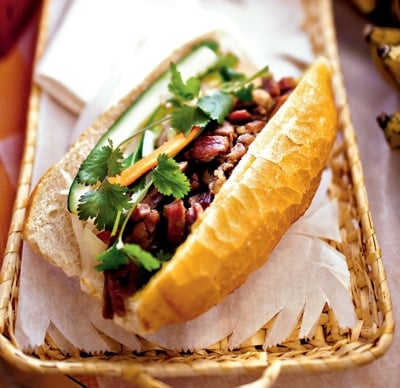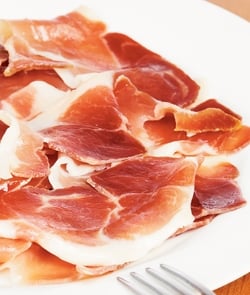
Bánh mì. A Vietnamese sub, born of the cultural collision that came of French colonialism in Vietnam. A humble meal that sells for less than $3 at Falls Church delis, it has been turning up on the menus of some of the area’s hottest restaurants. At the Source’s lounge in downtown DC, a miniature rendition is the best kind of homage: serious and irresistible, and with not a trace of slumming.
Bar chefs. Also known as “mixologists.” We love knocking back their new-generation cocktails with house-made tonics, crystal-clear ice cubes, and arcane flavorings. Derek Brown and Tom Brown (the Passenger), Todd Thrasher (Restaurant Eve, PX), Gina Chersevani (PS 7’s), and Adam Bernbach (Proof, Estadio) are among the leaders of the area’s craft-cocktail movement, and their clever experiments have helped energize the food scene. But what’s wrong with being known as a bartender?
Bev Eggleston. The patron saint of the area’s local-food movement—name-checked by dozens of chefs on menus across the country and generally regarded with the awe reserved for a Nobel laureate. His EcoFriendly Foods is a major supplier of eggs, poultry, and pigs. Think of him as the anti–Sysco truck.
Cask ale. Hop-heads go into rapture at the mere mention of this beer, which is unfiltered, unpasteurized, and typically pulled from its cask container by hand. The brewer’s art has no purer expression.
Cobia. Every few years, a new white fish crops up on menus, and this variety from tropical and subtropical waters currently stars in the role previously played by Chilean sea bass and mahi mahi. It’s the fish of choice—thick and inoffensively flavored—for those who’d prefer to eat meat. Chefs tend to prepare cobia the way they would a pork loin, accenting it with heavy sauces or lots of starch.
Cochon 555. A pig roast elevated to high art; some would say overkill. This road show—wherein five chefs, five winemakers, and five roasted heirloom pigs are brought together in an orgy of eating and Iron Chef–style judging—made a stop in DC this spring. (Bourbon Steak’s David Varley went on to win the national competition.) Tickets are among the most in-demand items of the food year. Makes the Old Ebbitt Grill’s Oyster Riot look like a church social.
Confit. Strictly speaking, a piece of meat cooked and stored in its own fat. So how to explain a profusion of dishes with lemon, tomato, potato, and onion confit, among others? When asked, chefs typically claim a liberal interpretation, saying they cook these ingredients in their own juices. But we rarely encounter a non-meat confit that’s worthy of the term.
Consommé. An intensely flavorful broth with a see-through effect—you should be able to see the bottom of the bowl—that comes from meticulous straining of the stockpot. Palena chef Frank Ruta is a master, as is CityZen’s Eric Ziebold. But not every chef can pull it off. Our advice: Order only at the highest levels.
Crumbles. A small pile next to the ice cream or tart that looks as if someone forgot to clean the plate before sending it out. Strange as it may seem, crumbles—of streusel, of pie crust—are a sign that your pastry chef wants to be known as cutting edge. Often turns up alongside “deconstructed” pies, in which the fruit filling is rendered into jellied cubes and the crust is presented in cookie-like panes. Two iterations of this pieless pie, at the Oval Room and Vidalia, have left us with this plea for pastry chefs: It’s pie. It’s perfect as is. Leave it alone.
Cupping. The practice of sniffing, tasting, and assessing a cup of coffee. As coffee has become big business and specialty bean shops have sprung up, coffee drinking has become as serious—and sometimes as pretentious—as wine drinking.
Duck eggs. Prized by chefs for their large yolks, which tend to result in richer pastas and cakes. As a stand-alone ingredient, they’re mostly a case of a restaurant charging extra for a bit of exoticism; there’s not much difference in taste. We feel the same about quail eggs. Cute but not worth it.
Enomatic. Taps for wine. This trademarked system—embraced by Sonoma, Evo Bistro, and others—allows restaurants to dispense temperature-controlled wine from as many as three dozen bottles at once, as opposed to offering a few too-cold whites and too-warm reds.
Hanger steak. A favorite of the French, this inexpensive cut of beef is named for meat that hangs off the rib cage of the cow. Long, thin, and virtually fatless, it’s gamier—because of its proximity to the liver—than a New York strip or porterhouse. In the Washington area, where meats lack the savor of the Midwest, we’ll take a hanger any day over its more revered—and costly—counterparts.

Ibérico ham. This granddaddy of hams has become a major presence in wine bars and Spanish restaurants. Its distinctive, nutty taste comes from pigs fed a diet of acorns. To all of us who came of age eating Oscar Mayer, it’s like being upgraded from steerage to first class.
Izakaya. Quick-service taverns that cater to Japanese professionals—as common in Tokyo as sports bars are in the States. Blue Ocean in Fairfax, Hinode in Rockville and Bethesda, and Sushi Taro in DC were among the first to offer izakaya-style dining here, but the term didn’t catch on until the arrival of DC’s Kushi earlier this year. Interestingly, Taro ditched its izakaya concept in favor of becoming a purveyor of top-of-the-line raw fish, transforming itself into the area’s best sushi restaurant—which Kushi is now bent on challenging. With an izakaya menu.
Kimchee. Pickled, spicy cabbage left to ferment in the jar for weeks or months—a Korean staple. As Korean food has drifted into the mainstream, kimchee has found its way into fine-dining preparations. One way to appreciate its appeal is to try a kimchee quesadilla at Annandale’s DaMoim: fusion at its finest.
Mâche. Also called lamb’s lettuce. A staple of French cookery since the 17th century, it has been embraced by a new generation of American chefs who regard this verdant effusion—pronounced “mahsh”—as the quintessence of lettuce: a delicately flavorful, highly versatile ingredient. Ironically, its emergence has coincided with the revival of iceberg lettuce, its stylistic opposite.
Rillettes. Meat cooked in its own fat, shredded, and mixed into a thick paste. Done right, it’s more delicious than it sounds. The technique has become a badge of honor among young chefs intent on showing their mastery of butchering, sausage making, and other manly arts.
This article first appeared in the October 2010 issue of The Washingtonian.

















